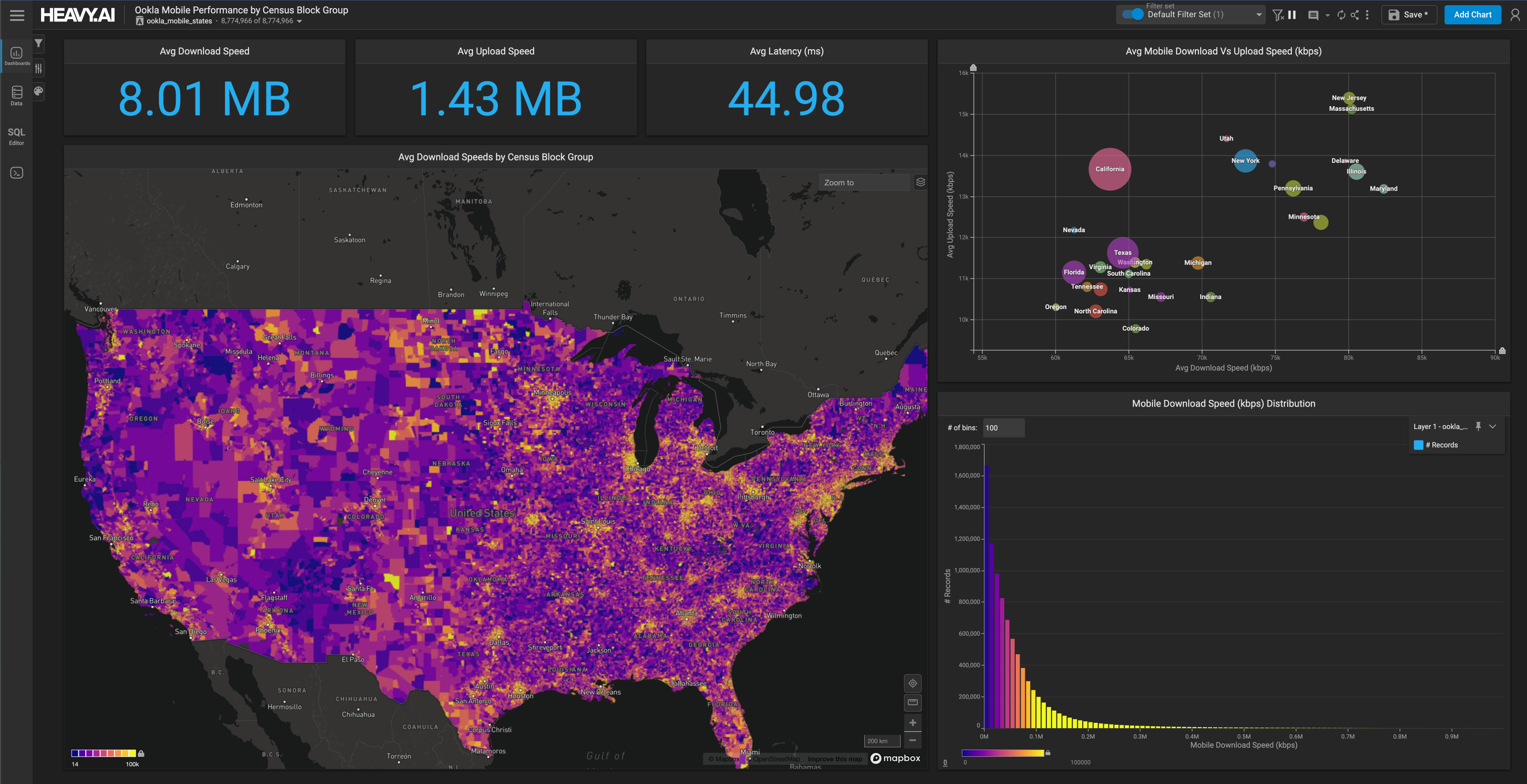
Introducing HeavyRF: Accelerated Cell Site Planning for Telcos
Download HEAVY.AI Free, a full-featured version available for use at no cost.
GET FREE LICENSEAs telcos race to construct 5G networks that can provide higher-bandwidth, lower-latency connections to billions of people around the globe, there is an unprecedented need to fuse near real-time, physically accurate simulation capabilities with granular customer data. On one hand, the shorter range and mostly line-of-sight propagation characteristics of 5G, especially in its high-frequency millimeter-wave variants, requires incredibly high resolution modeling of RF characteristics of the physical world. With 5G, even a single tree between a cell repeater and a customer’s window can have a dramatic impact on their coverage quality. The flip-side of this equation, particularly given the massive investments being poured into 5G rollouts, is that it is equally critical for a telco to know the locations that will be frequented by its customers throughout the day. After all, high-quality coverage delivered to empty spaces does little good, and even a single constrained spot where a customer’s calls drop repeatedly on their evening commute can cause them to think about switching to a telco’s competitors.
As announced here and here, we are developing the HeavyRF RF Propagation module, and our platform integration with Nvidia Omniverse, as an entirely new way for telcos to connect their 4G and 5G planning efforts with their customer acquisition and retention efforts. Those resources go into more detail on the various use cases, so here I wanted to use the opportunity to talk about what was happening technically behind the scene, particularly in regards to the various differentiated capabilities in the HEAVY.AI and Nvidia Omniverse platforms that make these use cases possible.

As can be seen from the stack slide, above, the engine behind the HeavyRF offering is HeavyDB, our lightning-fast GPU-accelerated SQL database that allows tens of billions of records to be queried and visualized in milliseconds, no indexing or pre-computation required. By tapping into the massive computational capabilities and memory bandwidth of Nvidia GPUs, HeavyDB enables users of everything else built on top, whether our own visual analytics frontend Heavy Immerse, or our integration with Nvidia Omniverse, to interact with massive datasets at the speed of thought instead of waiting the minutes or sometimes hours that CPU-based legacy solutions take to query the same data.
While many datasets are necessary to power RF Propagation use cases, as can be seen in the “Input Datasets”section of the above slide, the largest of these datasets is terrain and ‘clutter’ data itself. In particular, HeavyRF is differentiated in its ability to transform massive amounts of LiDAR 3D point cloud data to a high-fidelity terrain model. Now commonly available for free in many countries at 10cm resolution or better, a typical LiDAR dataset contains many billions of points for a single city. This allows the construction of an incredibly high-resolution model of the buildings, vegetation, roads, and other myriad of features that comprise urban terrain.
Conventional tools tend to choke on the required data volumes. But by leveraging HeavyDB to geospatially bin this massive point cloud data at sub-second speeds, network planners or operators can dynamically choose the resolution of their RF models without waiting for costly ETL. Whatever resolution is chosen, the vastly superior scaling and performance characteristics of HeavyDB makes the coarse 10 meter models of old a thing of the past, with interactive 1 meter models of an entire city an easy lift.
At the heart of HeavyRF is the RF model itself, and here the HEAVY.AI platform again enables unprecedented levels of performance by running the model directly in the database itself, in-situ, without copying the data off-platform or off-machine. Big data, after all, is heavy, it has gravity, and moving hundreds of gigabytes or terabytes of data between systems would take minutes to hours under the best circumstances. So just as we allow the in-situ rendering of billions of records of data directly on GPU, HeavyDB allows for the zero-data-copy execution of custom algorithms on both GPU and CPU.
Of course, the native SQL of HeavyDB is not necessarily the best tool to orchestrate the complex ray-tracing algorithms necessary to compute RF propagation. So here we rely on the native SQL construct of “table functions” to enable running the RF model inline. We use SQL queries to select the relevant terrain/LiDAR data and the location of cell towers and buildings. Table functions are also composable, so we can use subqueries touching multiple tables as inputs, and pass results efficiently to other table functions or query results to form a final output.
In HEAVY.AI, table functions can be written in C++ or the Numba subset of Python, and are directly compiled to GPU and CPU machine code that is inlined with the rest of the machine code we generate for a query. This means that even a simple UDF authored in Python running on an 8XA100 Nvidia DGX can take advantage of over 12TB/sec of memory bandwidth and 156 TFlops of computational power, effectively delivering the power of a cloud-deployable supercomputer to end users.
With all of this infrastructure and data at our disposal, the model itself can be relatively simple, while still being an order of magnitude faster than conventional alternatives. In concept, our approach is very similar to optical ray tracing. We leverage native platform parallelism and take a physically-based approach, casting rays from specified antennas. Rays gradually lose power over distance, following a well-known phenomenon known as “free space power loss.” When those rays intersect with vegetation, further attenuation occurs. This is proportional to the “optical thickness” of that vegetation, which we can determine statically from LiDAR data or adjust seasonally based on remote sensing observations. Lastly, rays can either reflect off of buildings or penetrate them, a phenomenon of course mediated by building materials.
As we work further with our telco partners, we plan to further extend our modeling capabilities in several ways. The first is to make it easier to extend the core RF model with different path loss functions, such as for satellite transmission calculations. Second, we plan to integrate with NVIDIA’s libraries for antenna, link and materials simulation. This will allow the design of new devices and networks to be tested within a physically-informed digital twin environment. Lastly we plan to exploit ML methods to help both in city modeling and in the automation of cell site selection and configuration.
Perhaps the most exciting new developments are not in RF modeling per se, but rather in its integration within new interactive visualization environments. Today the output of the HeavyRF module can be consumed directly via SQL, or visualized in plan view in Heavy Immerse, our interactive visual analytics application. However, we’ve found that the most natural way to consume and explore a signal propagation model is with interactive 3D.
The Nvidia Omniverse is a fully 3D world-scale simulation platform, with integrations already available to an impressive variety of reality capture and content creation tools. As can be seen in the video above, the HeavyRF integration with Nvidia Omniverse allows constituents from across a telco’s network and business sides to see the impacts of various network planning and optimization scenarios on customers and prospective customers interactively and in real-time. Not only does the HeavyRF Omniverse integration allow for easy and fast simulation of tower deployments or changes to existing tower parameters, but it also breaks down the impact of those changes by the customer demographics affected, down to the building level.
How did we accomplish this, and more specifically, how did we do this with a small team in just a few months? On the user interface side, we leveraged a development environment known as Nvidia Omniverse, a highly-modular Python-based SDK with 3D optical ray tracing built in. To build a telco digital twin, we rely on the core HEAVY.AI platform to ingest LiDAR and antenna data. We use the same RF model as in Immerse, but leverage Omniverse for its immersive 3D visualization and object manipulation capabilities. We added RF properties to geometric objects, so that antennas have transmitter properties and vegetation and buildings have RF material properties.
This is again an area where HEAVY.AI’s ability to execute complex SQL queries locally against big geotemporal data is significant. Taking the output of the RF model table function as a base, we join the results to business data of several types and scales. For example, we integrate building envelopes with demographic data and parcel information. We also can use anonymized GPS data to determine activity levels anywhere in the landscape, by hour of day or day of week. At the most basic level, this lets us determine the aggregate count and level of service being provided to active commercial and residential customers. At a more nuanced level, this allows targeting of any number of specific business priorities. We can test coverage just to Starbucks locations, just to customers likely to switch carriers, or to those at risk of churning.
Ultimately, telco revenues are driven by the quality of service delivered where people live, work and play. It is a demanding and competitive industry, and perceptions are driven not by the best service delivered, but by the worst. In providing this service, operators have a dizzying array of options. Yet most of these require large capital investments up front. So the ultimate value of digital twins in this context is the opportunity to experiment and test scenarios easily and cheaply. By integrating customer and business data with network modeling algorithms, HEAVY.AI can help ensure that the business impact of prospective network changes remain front and center in the network planning and operations processes.
To learn more about how HEAVY.AI and NVIDIA Omniverse helps telcos obtain and keep customers while lowering costs, please join our upcoming webinar with NVIDIA and Bain Consulting on October 11, 2022. Register here.




